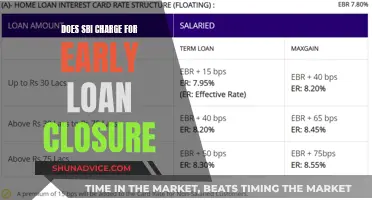
SunTrust Banks, Inc. merged with BB&T Corporation in 2019 to create Truist Financial Corporation. The new entity, Truist, offers a range of mortgage products, including specialised physician loans for medical professionals. These loans are designed to help doctors and dentists secure financing for their homes, with features such as low down payments, no private mortgage insurance, and flexibility in managing student loan debt. While Truist does not refinance medical loans specifically, its physician loans can help medical professionals manage their finances and debt.
| Characteristics | Values |
|---|---|
| SunTrust | Merged with BB&T Corporation in 2019 to become Truist Financial Corporation |
| Truist Financial Corporation | Offers a range of mortgage products, including HELOCs and construction-to-permanent loans |
| Physician Loan | Available to medical professionals with specific designations, including MD, DO, DPM, DDS, and DMD |
| Open to practicing physicians, residents, and fellows with less than 10 years of experience | |
| High maximum loan amount ($2 million), low down payments, competitive rates, and high loan limits | |
| No private mortgage insurance (PMI) | |
| Available in 22 states, with an additional 25 states for Truist account holders |
What You'll Learn

Truist Bank's physician loan program
Truist Bank, the result of a merger between SunTrust and BB&T, offers a physician loan program designed for medical professionals. The program provides attractive features like low down payments, competitive rates, and high loan limits.
The Truist Physician Loan is available to medical professionals with specific designations, including MD, DO, DPM, DDS, and DMD. It is open to practicing physicians, residents, and fellows who are early in their careers. However, Truist does not consider practicing physicians and dentists with over 10 years of experience to be eligible. The loan amount can go up to $2 million, which can lead to high monthly payments and potentially unmanageable debt.
The program offers lending programs customized for medical professionals, allowing them to bypass some traditional lending requirements and get attractive terms. The debt-to-income requirement is relaxed, and borrowers will not need to pay private mortgage insurance (PMI). Truist also offers business and personal banking services, allowing individuals to keep all their accounts in one place.
The Truist Physician Loan is available in 22 states for non-account holders, and an additional 25 states are available for Truist account holders. The bank also allows for cash-out refinancing, where borrowers can refinance up to 80% of their appraisal value and take up to $50,000 in cash while using the remaining funds to pay off debt.
How SAP Influences Loan Eligibility and Access
You may want to see also

Physician mortgage loan programs
One example of a physician mortgage loan program is Truist Bank, previously known as SunTrust, which offers lending programs customised for medical professionals early in their careers. Truist's physician loan program provides competitive rates, high borrowing limits, and the convenience of a full-service bank. The loan is available to medical professionals with specific designations, including MD, DO, DPM, DDS, and DMD, and is open to practicing physicians, residents, and fellows. However, Truist does not consider practicing physicians and dentists with over 10 years of experience to be eligible.
Another example is TD's Medical Professional Mortgage, which allows physicians to borrow up to 100% of the home's value up to $1,000,000, 95% financing up to $1,500,000, and 89.99% financing up to $2,000,000. TD's program also offers flexibility in purchasing a single-family residence, condominium, or planned unit development.
Other banks that provide physician mortgage loan programs include U.S. Bank, Huntington Bank, Northwest Bank, CrossCountry, and Academy Bank. These programs offer benefits such as flexible debt-to-income ratios, low down payments, and tailored financing options for physicians.
When considering a physician mortgage loan, it is important to shop around and explore alternatives to find the best option for your unique financial needs.
Stafford Loans: Repayment Obligations and Your Options
You may want to see also

SunTrust's merger with BB&T
SunTrust and BB&T merged in December 2019 to become Truist Bank. The merger was first announced on February 7, 2019, and final regulatory approval was received on November 19, 2019. The Federal Deposit Insurance Corporation (FDIC) unanimously approved the merger, which resulted in Truist becoming one of the top 10 commercial banks in the country.
Truist is a purpose-driven financial services company, offering a wide range of services, including retail, small business, and commercial banking, as well as asset management, capital markets, and insurance. The merger has allowed Truist to increase investment in innovative technology and create a distinctive client experience.
The new corporation offers a range of loan products, including the Truist Physician Loan, which is available to medical professionals with specific designations, such as MD, DO, DPM, DDS, and DMD. This loan offers attractive features like low down payments, competitive rates, and high loan limits of up to $2 million.
The merger did not result in any changes to account numbers or routing numbers for the majority of clients, and they can continue to be served through their respective BB&T or SunTrust branches, websites, and mobile apps. The transition to the full Truist experience will occur over time as the systems are integrated.
Title Signing: Does it Release You From Loans?
You may want to see also

High loan amounts and competitive rates
SunTrust Bank merged with BB&T in December 2019 to become Truist Bank. The new entity offers a range of financial services, including the Truist Physician Loan. This loan is designed for medical professionals with specific designations, including MD, DO, DPM, DDS, and DMD. It is open to practicing physicians, residents, and fellows with less than 10 years of experience.
The Truist Physician Loan offers high loan amounts, with borrowers able to take out up to $2 million. This high maximum loan amount can be advantageous for medical professionals seeking to purchase a home or finance other significant expenses. However, it is important to note that borrowing such a large amount can result in high monthly payments and potentially unmanageable debt.
In addition to the high loan amounts, the Truist Physician Loan also offers competitive interest rates compared to other large banks in the US. The interest rates on physician loans are generally better than those of conventional loans. As of January 2025, Truist's annual percentage rates (APRs) for personal loans ranged from 5.49% to 15.99%, with lower rates available for borrowers with high credit scores.
Furthermore, Truist waives the requirement for private mortgage insurance (PMI) on its physician loans, which can result in significant savings for borrowers. The debt-to-income (DTI) requirement is also relaxed for these loans, providing more flexibility for medical professionals.
ATV Loans: Sheffield Finance and Insurance Options
You may want to see also

Physician loan eligibility
Physician mortgage loans are designed for medical professionals with specific designations, including MD, DO, DPM, DDS, and DMD. These loans are available to practicing physicians, residents, and fellows. However, some banks, like Truist, do not consider practicing physicians and dentists with over 10 years of experience to be eligible.
These loans are designed to help medical professionals secure home financing by offering attractive features like low or no down payments, competitive rates, and high loan limits. For example, Truist Bank offers lending programs with high borrowing limits of up to $2 million, competitive rates, and the convenience of a full-service bank. Similarly, Huntington Bank offers flexible physician mortgage options for medical doctors, dentists, podiatrists, and veterinarians, approving mortgages for physicians with a high debt-to-income (DTI) ratio of up to 50%.
It is important to note that physician mortgage loans are not only for physicians but are also available to other qualifying medical professionals. For instance, the DFCU Doctor Mortgage program offers loans to individuals credentialed as MD, DO, DDS, DC, DMD, or DVM. Additionally, U.S. Bank provides doctor loan programs specifically for MDs and DOs.
When considering a physician mortgage loan, it is wise to shop around and explore alternatives. While these loans offer advantages, they may also lead to high monthly payments and potentially unmanageable debt. It is crucial to evaluate the pros and cons to determine if this type of loan is the right choice for your financial situation.
Speedy Cash Installment Loans: Available in Oklahoma?
You may want to see also
Frequently asked questions
Truist's Physician Loan is a mortgage product designed for medical professionals with specific designations, including MD, DO, DPM, DDS, and DMD. It is open to practicing physicians, residents, and fellows who are early in their careers. The loan offers attractive features like low down payments, competitive rates, and high loan limits of up to $2 million.
To qualify for a Truist Physician Loan, you must hold one of the designated medical degrees (MD, DO, DPM, DDS, or DMD) and be a practicing physician, resident, or fellow with less than 10 years of experience. You will also need to provide your medical licenses and any other relevant paperwork.
The Truist Physician Loan offers several benefits, including low to no down payment options, no private mortgage insurance (PMI), and flexibility in handling student loan debt. Additionally, the loan provides competitive interest rates and the convenience of a full-service bank.







